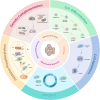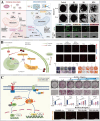An emerging role of mitochondrial quality control in bone metabolism: from molecular mechanisms to targeted therapeutic interventions
- PMID: 40728722
- PMCID: PMC12307276
- DOI: 10.1007/s00018-025-05802-w
An emerging role of mitochondrial quality control in bone metabolism: from molecular mechanisms to targeted therapeutic interventions
Abstract
The mitochondrial quality control system is the principal regulatory framework governing mitochondrial quantity, morphology, distribution, and functional integrity. This surveillance and regulatory machinery is essential for preserving cellular homeostasis and determining cellular differentiation. Mitochondria play a central role in maintaining the dynamic equilibrium between osteogenic differentiation and osteoclastic differentiation. Dysregulation of mitochondrial quality control can lead to disrupted mitochondrial homeostasis and functional impairments, disrupting the physiological processes of bone formation and bone resorption. However, comprehensive reviews elucidating the relationship between mitochondrial quality control and bone homeostasis are conspicuously lacking. This review systematically deconstructs the molecular architecture of mitochondrial quality control, elucidating the regulatory mechanism of each part (mitochondrial dynamics, mitophagy, mitochondrial biogenesis, mitochondrial redox) in bone-related cells. In addition, the mitochondrial quality control system in orchestrating cellular physiological activities is summarized to establish its indispensable in governing cellular homeostatic networks. Furthermore, the regulatory roles of the mitochondrial quality control system in bone-related cells and the balance between bone formation and resorption are reviewed. Finally, this review delineates the dysregulation of mitochondrial quality control in bone metabolic diseases and further advances mitochondrial quality control-targeted approaches for restoring mitochondria homeostasis, offering transformative strategies to treat bone metabolic diseases.
Keywords: Bone metabolism; Mitochondrial biogenesis; Mitochondrial dynamics; Mitochondrial quality control; Mitophagy; Oxidative stress.
© 2025. The Author(s).
Conflict of interest statement
Declarations. Ethics approval and consent to participate: Not applicable. Consent for publication: Not applicable. Conflict of interest: The authors declare no conflict of interest.
Figures







Similar articles
-
Mitochondrial dynamics dysfunction and neurodevelopmental disorders: From pathological mechanisms to clinical translation.Neural Regen Res. 2025 Jun 19. doi: 10.4103/NRR.NRR-D-24-01422. Online ahead of print. Neural Regen Res. 2025. PMID: 40537021
-
Mitochondrial quality control in hematopoietic stem cells: mechanisms, implications, and therapeutic opportunities.Stem Cell Res Ther. 2025 Apr 15;16(1):180. doi: 10.1186/s13287-025-04304-7. Stem Cell Res Ther. 2025. PMID: 40234908 Free PMC article. Review.
-
Role of mitochondria in physiological activities, diseases, and therapy.Mol Biomed. 2025 Jun 19;6(1):42. doi: 10.1186/s43556-025-00284-5. Mol Biomed. 2025. PMID: 40536597 Free PMC article. Review.
-
Copper dyshomeostasis and its relationship to AMPK activation, mitochondrial dynamics, and biogenesis of mitochondria: A systematic review of in vivo studies.J Trace Elem Med Biol. 2024 Dec;86:127549. doi: 10.1016/j.jtemb.2024.127549. Epub 2024 Oct 11. J Trace Elem Med Biol. 2024. PMID: 39427561
-
Role of impaired mitochondrial dynamics and mitophagy in cardiovascular diseases: Possible therapeutic approaches.Life Sci. 2025 Jul 30;379:123890. doi: 10.1016/j.lfs.2025.123890. Online ahead of print. Life Sci. 2025. PMID: 40749825 Review.
References
Publication types
MeSH terms
Grants and funding
- 82370935/National Natural Science Foundation of China
- 81870802/National Natural Science Foundation of China
- 2023YFS0244/Sichuan Province Science and Technology Support Program
- 2024-YF05-00505-SN/Key Research and Development Support Program of the Chengdu Science and Technology Bureau
- GSSCU2024105/Research Project on Graduate Education and Teaching Reform of Sichuan University
LinkOut - more resources
Full Text Sources

